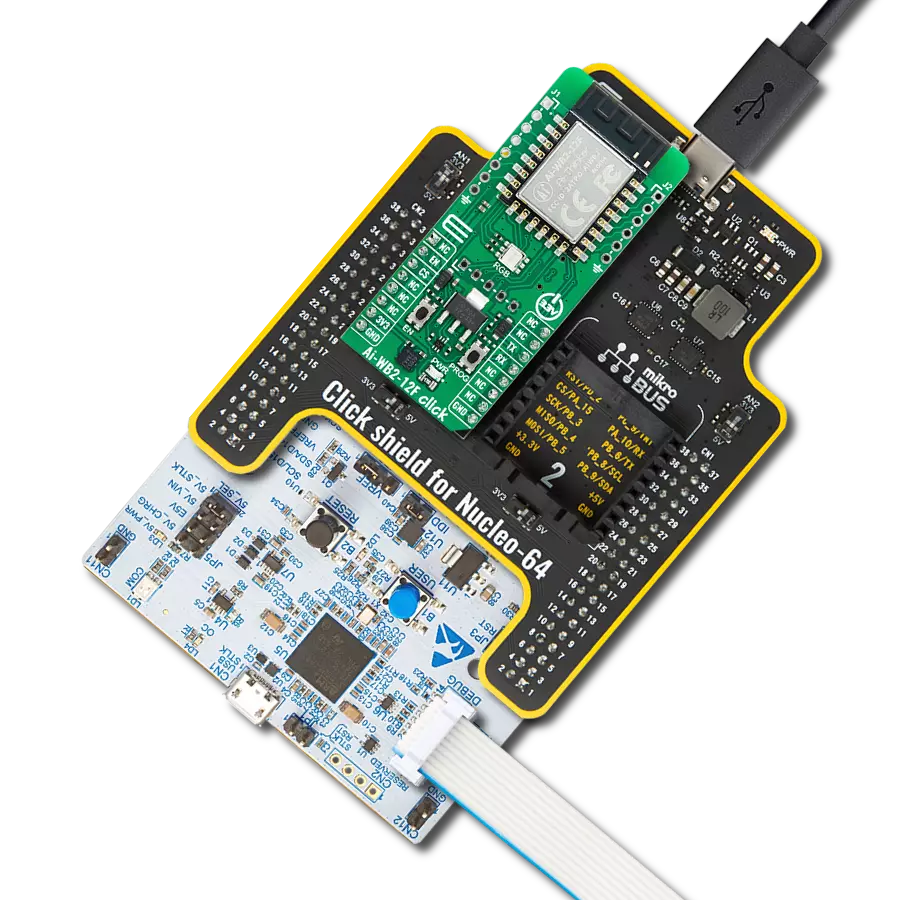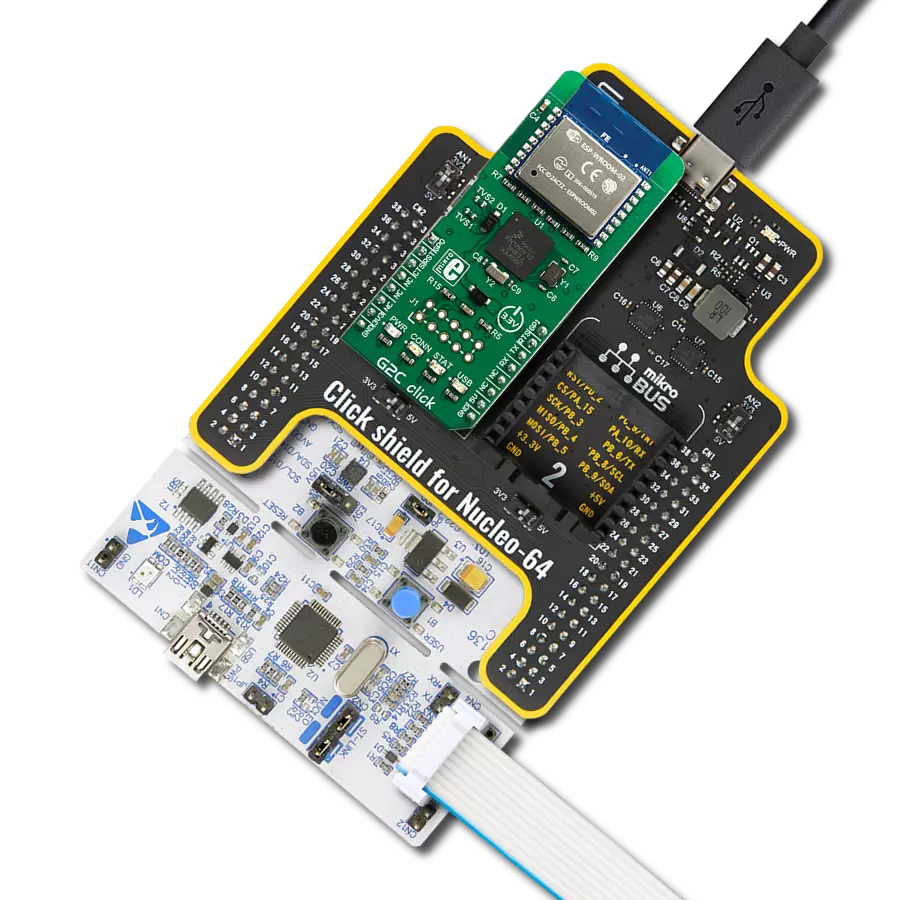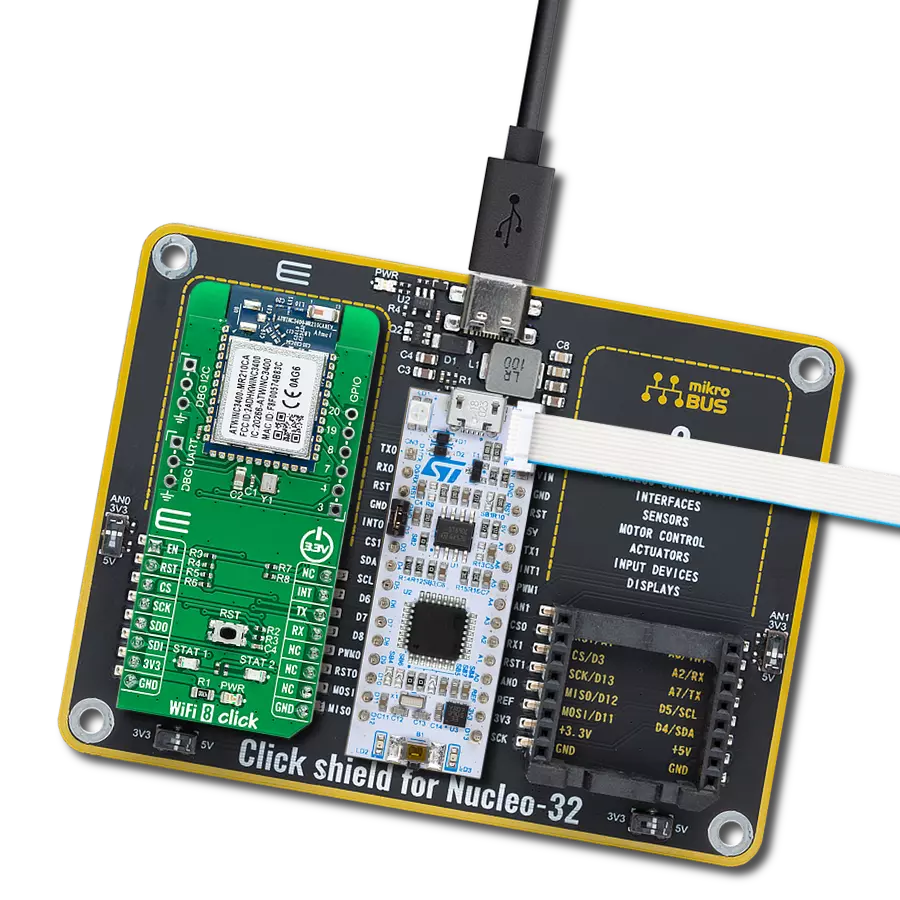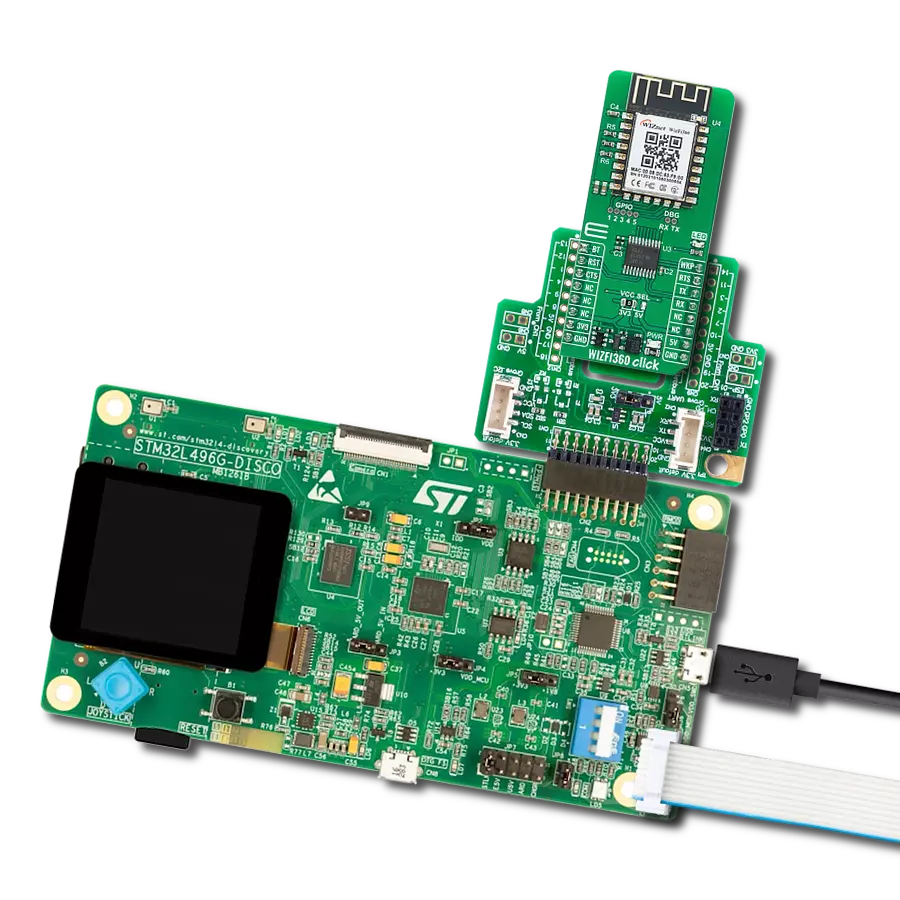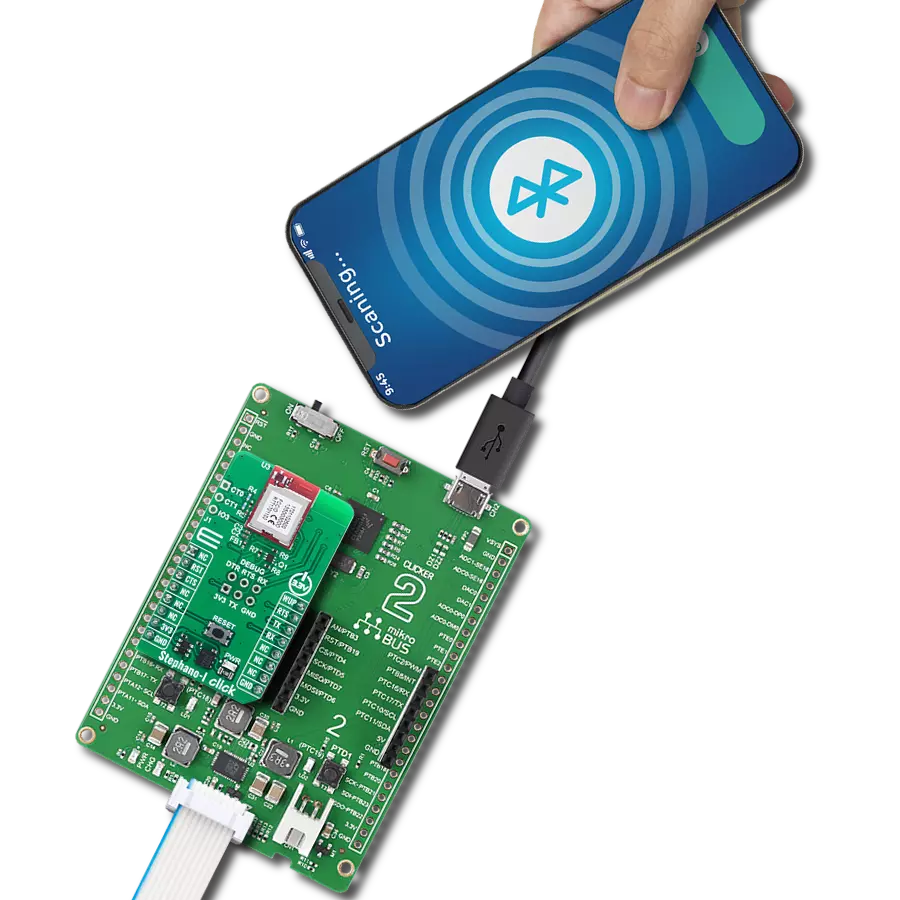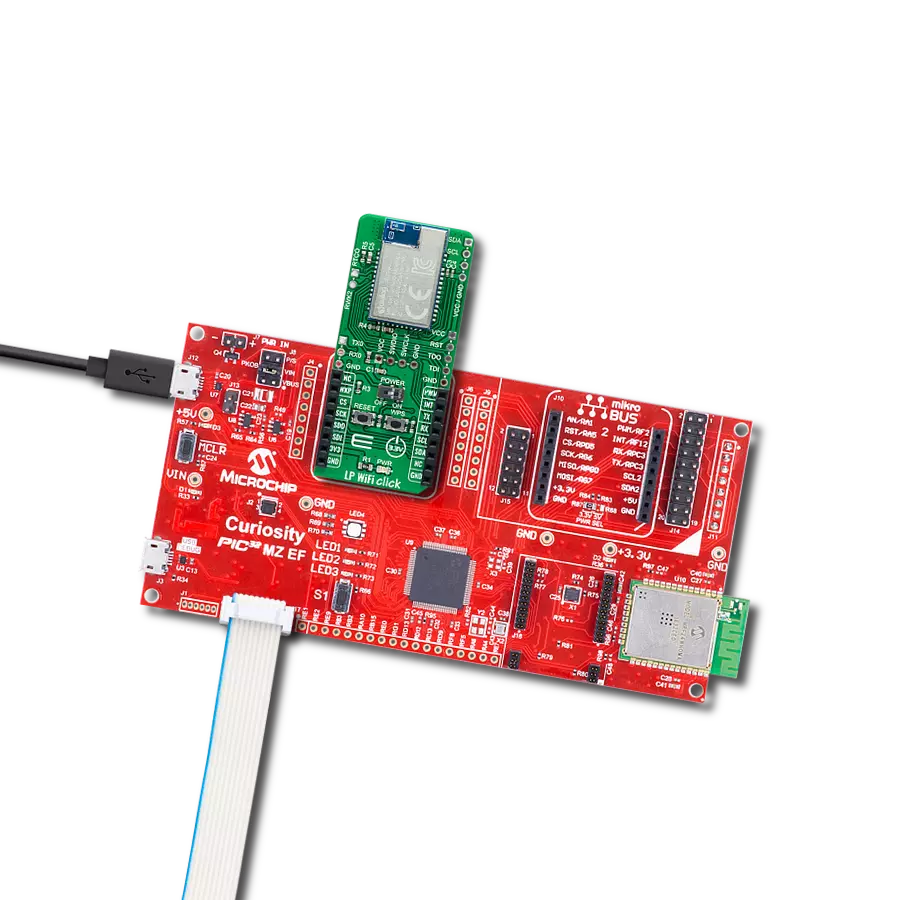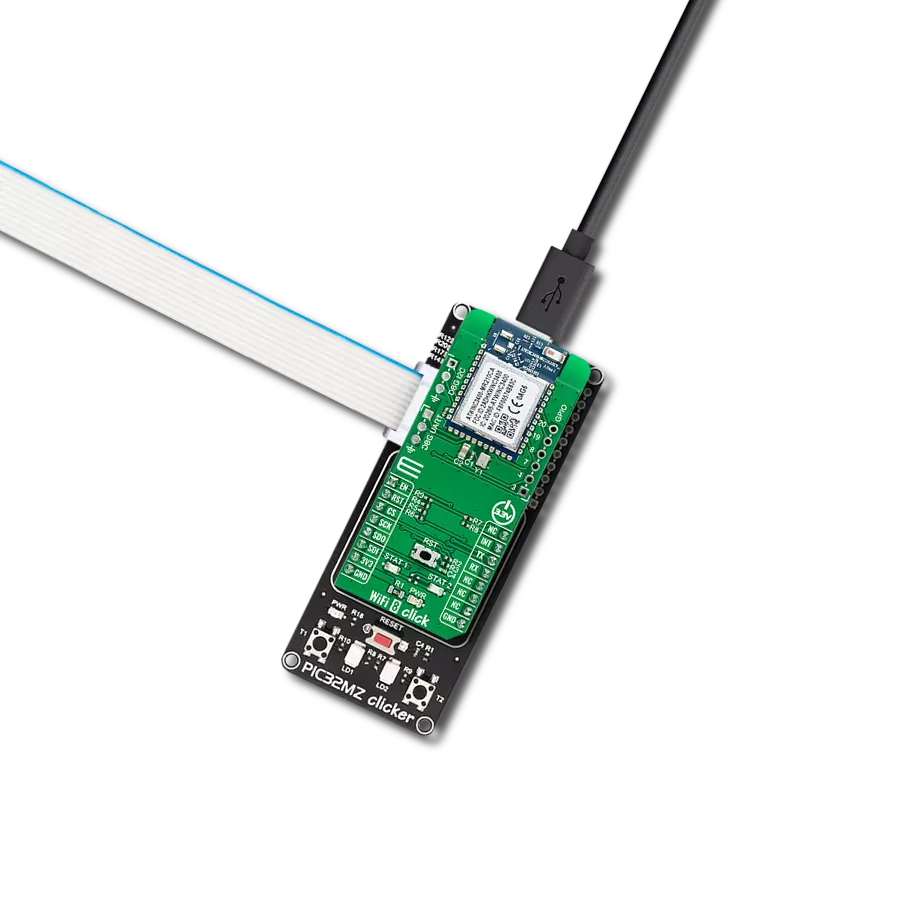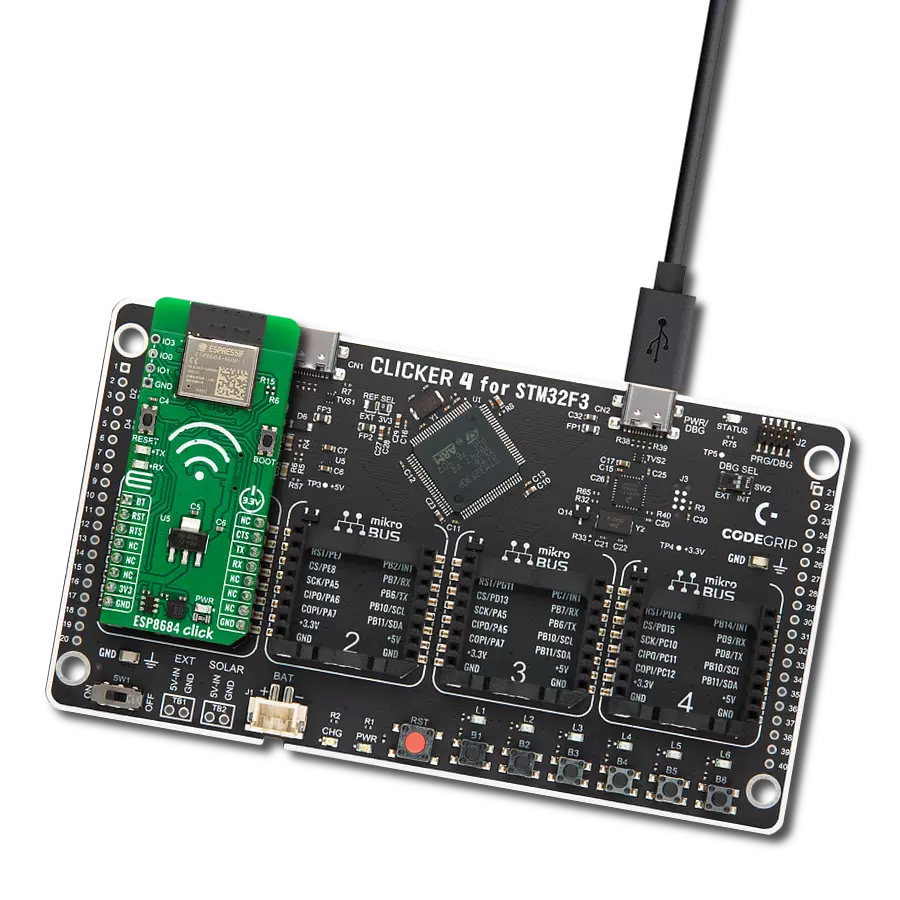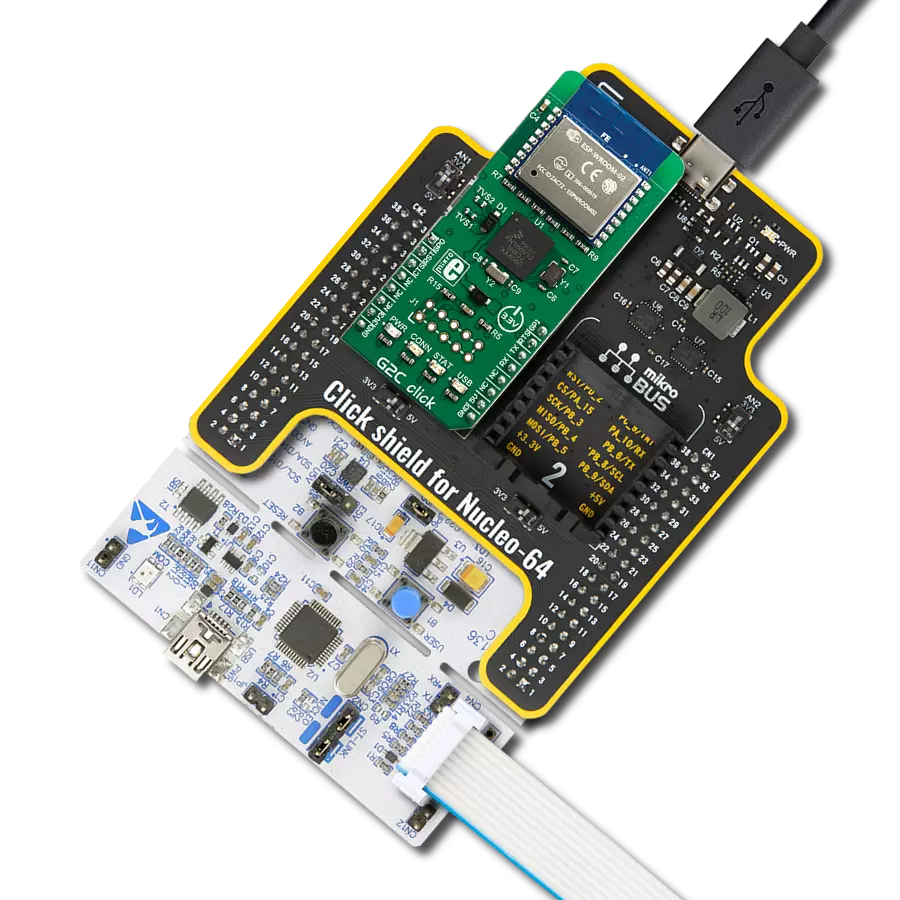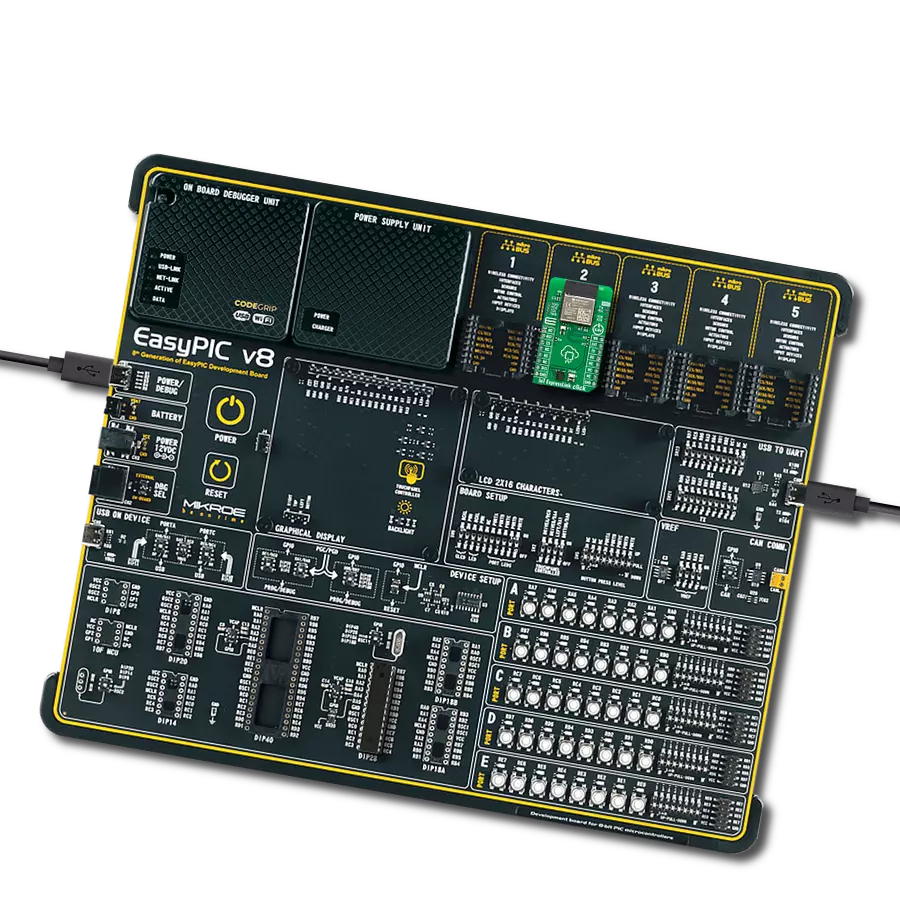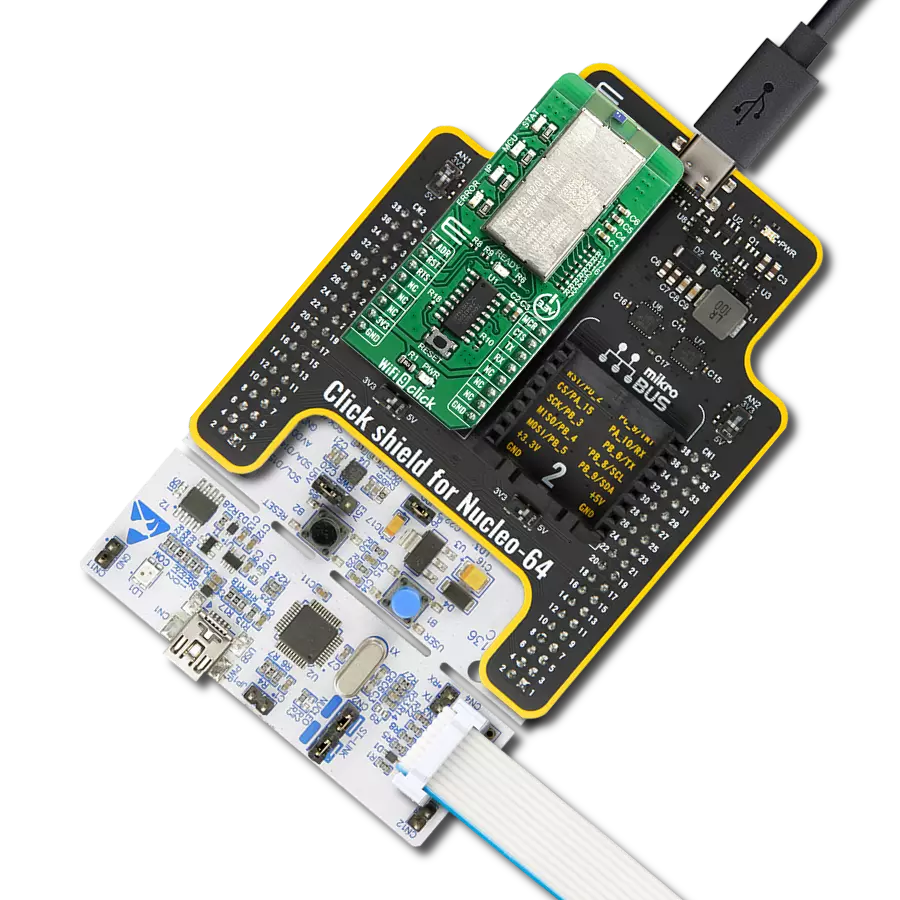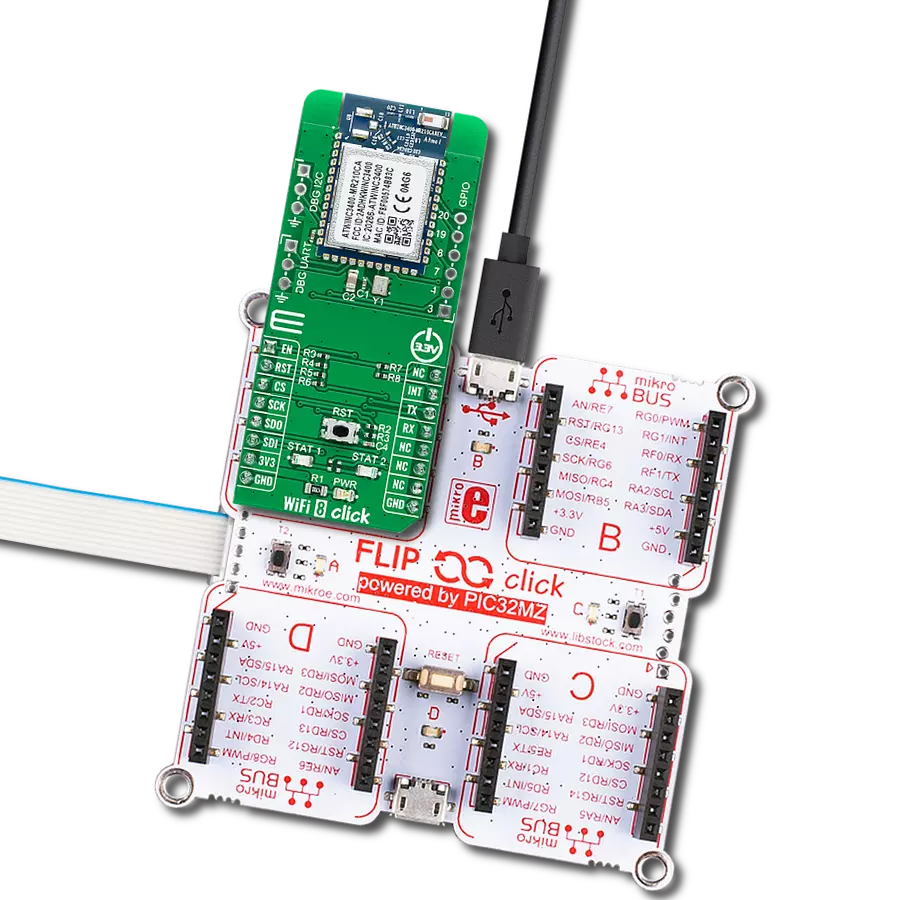Elevate your home network with our 2.4GHz WiFi solution, designed for brilliance in speed, coverage, and reliability, ensuring you stay connected effortlessly.
A
A
Hardware Overview
How does it work?
WiFi 9 Click is based on the PAN9420, a fully embedded Wi-FI module from Panasonic. The module combines a high-performance CPU, high-sensitivity wireless radio, baseband processor, medium access controller, encryption unit, boot ROM with patching capability, internal SRAM, and in-system programmable flash memory. The module’s integrated QSPI flash memory is available to the application for storing web content such as HTML pages or image data. Parallel support of access point and infrastructure mode allows easy setup of simultaneous Wi‑Fi connections from the module to smart devices and home network routers.
The pre‑programmed Wi-Fi SoC firmware enables client (STA), micro access point (µAP), and Ad‑hoc mode (Wi-Fi Direct) applications. With the transparent mode, raw data can be sent from the UART to the air interface to smart devices, web servers, or PC applications. For working with PAN9420 module at your disposal are two data UART interfaces, one for command and another for transparent data. In order to enable simultaneous communication between the module and host MCU through one UART on mikroBUS™ socket we have added 74HC4052 multiplexer from Nexperia. On the WiFi 9 click board several status LED’s are implemented
for easiest visual monitoring of the module states like MCU heartbeat, IP connectivity, Errors, WiFi connection and Booting. The PAN9420 supports Over-the-Air firmware updates. In order to make use of this feature, the customer needs to ensure that the appropriate preconditions are fulfilled and that a suitable environment is provided. This Click board™ can be operated only with a 3.3V logic voltage level. The board must perform appropriate logic voltage level conversion before using MCUs with different logic levels. Also, it comes equipped with a library containing functions and an example code that can be used as a reference for further development.
Features overview
Development board
Nucleo-64 with STM32F091RC MCU offers a cost-effective and adaptable platform for developers to explore new ideas and prototype their designs. This board harnesses the versatility of the STM32 microcontroller, enabling users to select the optimal balance of performance and power consumption for their projects. It accommodates the STM32 microcontroller in the LQFP64 package and includes essential components such as a user LED, which doubles as an ARDUINO® signal, alongside user and reset push-buttons, and a 32.768kHz crystal oscillator for precise timing operations. Designed with expansion and flexibility in mind, the Nucleo-64 board features an ARDUINO® Uno V3 expansion connector and ST morpho extension pin
headers, granting complete access to the STM32's I/Os for comprehensive project integration. Power supply options are adaptable, supporting ST-LINK USB VBUS or external power sources, ensuring adaptability in various development environments. The board also has an on-board ST-LINK debugger/programmer with USB re-enumeration capability, simplifying the programming and debugging process. Moreover, the board is designed to simplify advanced development with its external SMPS for efficient Vcore logic supply, support for USB Device full speed or USB SNK/UFP full speed, and built-in cryptographic features, enhancing both the power efficiency and security of projects. Additional connectivity is
provided through dedicated connectors for external SMPS experimentation, a USB connector for the ST-LINK, and a MIPI® debug connector, expanding the possibilities for hardware interfacing and experimentation. Developers will find extensive support through comprehensive free software libraries and examples, courtesy of the STM32Cube MCU Package. This, combined with compatibility with a wide array of Integrated Development Environments (IDEs), including IAR Embedded Workbench®, MDK-ARM, and STM32CubeIDE, ensures a smooth and efficient development experience, allowing users to fully leverage the capabilities of the Nucleo-64 board in their projects.
Microcontroller Overview
MCU Card / MCU
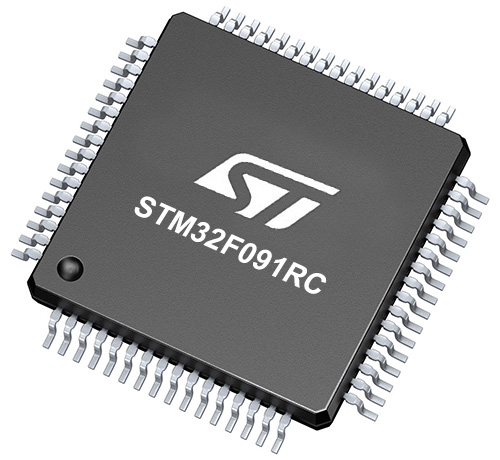
Architecture
ARM Cortex-M0
MCU Memory (KB)
256
Silicon Vendor
STMicroelectronics
Pin count
64
RAM (Bytes)
32768
You complete me!
Accessories
Click Shield for Nucleo-64 comes equipped with two proprietary mikroBUS™ sockets, allowing all the Click board™ devices to be interfaced with the STM32 Nucleo-64 board with no effort. This way, Mikroe allows its users to add any functionality from our ever-growing range of Click boards™, such as WiFi, GSM, GPS, Bluetooth, ZigBee, environmental sensors, LEDs, speech recognition, motor control, movement sensors, and many more. More than 1537 Click boards™, which can be stacked and integrated, are at your disposal. The STM32 Nucleo-64 boards are based on the microcontrollers in 64-pin packages, a 32-bit MCU with an ARM Cortex M4 processor operating at 84MHz, 512Kb Flash, and 96KB SRAM, divided into two regions where the top section represents the ST-Link/V2 debugger and programmer while the bottom section of the board is an actual development board. These boards are controlled and powered conveniently through a USB connection to program and efficiently debug the Nucleo-64 board out of the box, with an additional USB cable connected to the USB mini port on the board. Most of the STM32 microcontroller pins are brought to the IO pins on the left and right edge of the board, which are then connected to two existing mikroBUS™ sockets. This Click Shield also has several switches that perform functions such as selecting the logic levels of analog signals on mikroBUS™ sockets and selecting logic voltage levels of the mikroBUS™ sockets themselves. Besides, the user is offered the possibility of using any Click board™ with the help of existing bidirectional level-shifting voltage translators, regardless of whether the Click board™ operates at a 3.3V or 5V logic voltage level. Once you connect the STM32 Nucleo-64 board with our Click Shield for Nucleo-64, you can access hundreds of Click boards™, working with 3.3V or 5V logic voltage levels.
Used MCU Pins
mikroBUS™ mapper
Take a closer look
Click board™ Schematic

Step by step
Project assembly
Software Support
Library Description
This library contains API for WiFi 9 Click driver.
Key functions:
wifi9_select_uart- Switch to a command or binary uartwifi9_reset_device- Module reset.wifi9_send_command- Send Command function.
Open Source
Code example
The complete application code and a ready-to-use project are available through the NECTO Studio Package Manager for direct installation in the NECTO Studio. The application code can also be found on the MIKROE GitHub account.
/*!
* \file
* \brief WiFi 9 Click example
*
* # Description
* This application showcases capability of the WiFi 9 Click board.
* It initializes device, connects to local WiFi. Creates TCP server, waits for connection,
* and logs every message it receives from clients and returns back those messages as an echo response.
*
* The demo application is composed of two sections :
*
* ## Application Init
* Initializes driver and wifi communication, then connects to the desired WiFi network
* and creates TCP server on the IP address assigned to the Click board.
*
* ## Application Task
* All data received from the TCP clients will be logger to USB UART and echoed back to the clients.
*
* ## Additional Function
* - static void wifi9_clear_app_buf ( void )
* - static err_t wifi9_process ( void )
* - static void wifi9_log_app_buf ( void )
* - static err_t wifi9_rsp_check ( uint8_t *rsp )
*
* \author MikroE Team
*
*/
// ------------------------------------------------------------------- INCLUDES
#include "board.h"
#include "log.h"
#include "wifi9.h"
#include "string.h"
// Example parameters
#define EXAMPLE_SSID "MikroE Public"
#define EXAMPLE_PASSWORD "mikroe.guest"
#define EXAMPLE_SERVER_PORT "1234"
// Application buffer size
#define APP_BUFFER_SIZE 256
#define PROCESS_BUFFER_SIZE 256
// ------------------------------------------------------------------ VARIABLES
/**
* @brief Application example variables.
* @details Variables used in application example.
*/
static uint8_t app_buf[ APP_BUFFER_SIZE ] = { 0 };
static int32_t app_buf_len = 0;
static wifi9_t wifi9;
static log_t logger;
// ------------------------------------------------------- ADDITIONAL FUNCTIONS
/**
* @brief Clearing application buffer.
* @details This function clears memory of application
* buffer and reset its length.
*/
static void wifi9_clear_app_buf ( void );
/**
* @brief Data reading function.
* @details This function reads data from device and
* appends it to the application buffer.
* @return @li @c 0 - Some data is read.
* @li @c -1 - Nothing is read.
* See #err_t definition for detailed explanation.
*/
static err_t wifi9_process ( void );
/**
* @brief Logs application buffer.
* @details This function logs data from application buffer.
*/
static void wifi9_log_app_buf ( void );
/**
* @brief Response check.
* @details This function checks for response and
* returns the status of response.
* @param[in] rsp Expected response.
* @return @li @c 0 - OK response.
* @li @c -1 - Unknown error.
* @li @c -2 - Timeout error.
* See #err_t definition for detailed explanation.
*/
static err_t wifi9_rsp_check ( uint8_t *rsp );
// ------------------------------------------------------ APPLICATION FUNCTIONS
void application_init ( void )
{
log_cfg_t log_cfg;
wifi9_cfg_t cfg;
/**
* Logger initialization.
* Default baud rate: 115200
* Default log level: LOG_LEVEL_DEBUG
* @note If USB_UART_RX and USB_UART_TX
* are defined as HAL_PIN_NC, you will
* need to define them manually for log to work.
* See @b LOG_MAP_USB_UART macro definition for detailed explanation.
*/
LOG_MAP_USB_UART( log_cfg );
log_init( &logger, &log_cfg );
log_info( &logger, " Application Init " );
// Click initialization.
wifi9_cfg_setup( &cfg );
WIFI9_MAP_MIKROBUS( cfg, MIKROBUS_1 );
wifi9_init( &wifi9, &cfg );
wifi9_reset_device( &wifi9 );
wifi9_select_uart( &wifi9, WIFI9_SELECT_CMD_UART );
Delay_ms ( 1000 );
Delay_ms ( 1000 );
Delay_ms ( 1000 );
Delay_ms ( 1000 );
wifi9_process( );
wifi9_clear_app_buf( );
log_printf( &logger, "---------------------\r\n" );
log_printf( &logger, "---- System Info ----\r\n" );
log_printf( &logger, "---------------------\r\n" );
wifi9_send_command( &wifi9, WIFI9_CMD_GET_SYSTEM_FIRMWARE );
wifi9_rsp_check( WIFI9_CMD_GET_SYSTEM_FIRMWARE );
wifi9_log_app_buf( );
wifi9_send_command( &wifi9, WIFI9_CMD_GET_SYSTEM_MAC_ADDR );
wifi9_rsp_check( WIFI9_CMD_GET_SYSTEM_MAC_ADDR );
wifi9_log_app_buf( );
wifi9_send_command( &wifi9, WIFI9_CMD_GET_SYSTEM_SERIAL_NUM );
wifi9_rsp_check( WIFI9_CMD_GET_SYSTEM_SERIAL_NUM );
wifi9_log_app_buf( );
wifi9_send_command( &wifi9, WIFI9_CMD_GET_SYSTEM_RADIO_VER );
wifi9_rsp_check( WIFI9_CMD_GET_SYSTEM_RADIO_VER );
wifi9_log_app_buf( );
wifi9_send_command( &wifi9, WIFI9_CMD_GET_SYSTEM_BOOTL_VER );
wifi9_rsp_check( WIFI9_CMD_GET_SYSTEM_BOOTL_VER );
wifi9_log_app_buf( );
wifi9_send_command( &wifi9, WIFI9_CMD_GET_SYSTEM_HW_REV );
wifi9_rsp_check( WIFI9_CMD_GET_SYSTEM_HW_REV );
wifi9_log_app_buf( );
Delay_ms ( 1000 );
Delay_ms ( 1000 );
Delay_ms ( 1000 );
log_printf( &logger, "--------------------------\r\n" );
log_printf( &logger, "---- Start NETCAT app ----\r\n" );
log_printf( &logger, "--------------------------\r\n" );
log_printf( &logger, "\r\nSet Station to ON status: " );
wifi9_send_command( &wifi9, WIFI9_CMD_SET_WLAN_STATE_STA_ON );
wifi9_rsp_check( WIFI9_CMD_SET_WLAN_STATE );
wifi9_log_app_buf( );
Delay_ms ( 1000 );
Delay_ms ( 1000 );
Delay_ms ( 1000 );
log_printf( &logger, "\r\nSet Station SSID and PASSWORD: " );
strcpy( app_buf, WIFI9_CMD_SET_WLAN_CFG_STA );
strcat( app_buf, " \"" );
strcat( app_buf, EXAMPLE_SSID );
strcat( app_buf, "\" \"" );
strcat( app_buf, EXAMPLE_PASSWORD );
strcat( app_buf, "\" 4" );
wifi9_send_command( &wifi9, app_buf );
wifi9_rsp_check( WIFI9_CMD_SET_WLAN_CFG );
wifi9_log_app_buf( );
Delay_ms ( 500 );
log_printf( &logger, "\r\nTurn ON - Netcat module: " );
wifi9_send_command( &wifi9, WIFI9_CMD_SET_NETCAT_STATE_ON );
wifi9_rsp_check( WIFI9_CMD_SET_NETCAT_STATE );
wifi9_log_app_buf( );
Delay_ms ( 500 );
log_printf( &logger, "\r\nExclude Netcat authentication: " );
wifi9_send_command( &wifi9, WIFI9_CMD_SET_NETCAT_AUTH_OFF );
wifi9_rsp_check( WIFI9_CMD_SET_NETCAT_AUTH );
wifi9_log_app_buf( );
Delay_ms ( 500 );
log_printf( &logger, "\r\nSet the Netcat module server port: " );
strcpy( app_buf, WIFI9_CMD_SET_NETCAT_CFG_SERVER );
strcat( app_buf, " " );
strcat( app_buf, EXAMPLE_SERVER_PORT );
wifi9_send_command( &wifi9, app_buf );
wifi9_rsp_check( WIFI9_CMD_SET_NETCAT_CFG );
wifi9_log_app_buf( );
Delay_ms ( 1000 );
Delay_ms ( 1000 );
Delay_ms ( 1000 );
log_printf( &logger, "\r\nWaiting for an IP address assignment from DHCP server...\r\n" );
for ( ; ; )
{
log_printf( &logger, "\r\nGet IP address: " );
wifi9_send_command( &wifi9, WIFI9_CMD_GET_NET_CFG_STA );
wifi9_rsp_check( WIFI9_CMD_GET_NET_CFG );
wifi9_log_app_buf( );
if ( !strstr ( app_buf, "0.0.0.0" ) )
{
break;
}
Delay_ms ( 1000 );
Delay_ms ( 1000 );
Delay_ms ( 1000 );
Delay_ms ( 1000 );
Delay_ms ( 1000 );
}
wifi9_clear_app_buf( );
Delay_ms ( 1000 );
log_printf( &logger, "\r\nNow you can connect to the TCP server listed above via a TCP client app\r\n" );
log_printf( &logger, "The module is transferred to BIN-UART - for data collection\r\n" );
wifi9_select_uart( &wifi9, WIFI9_SELECT_BIN_UART );
log_info( &logger, " Application Task " );
Delay_ms ( 1000 );
}
void application_task ( void )
{
wifi9_process( );
if ( app_buf_len )
{
wifi9_log_app_buf( );
wifi9_generic_write( &wifi9, app_buf, app_buf_len );
wifi9_clear_app_buf( );
Delay_ms ( 100 );
}
}
int main ( void )
{
/* Do not remove this line or clock might not be set correctly. */
#ifdef PREINIT_SUPPORTED
preinit();
#endif
application_init( );
for ( ; ; )
{
application_task( );
}
return 0;
}
static void wifi9_clear_app_buf ( void )
{
memset( app_buf, 0, app_buf_len );
app_buf_len = 0;
}
static err_t wifi9_process ( void )
{
uint8_t rx_buf[ PROCESS_BUFFER_SIZE ] = { 0 };
int32_t rx_size = 0;
rx_size = wifi9_generic_read( &wifi9, rx_buf, PROCESS_BUFFER_SIZE );
if ( rx_size > 0 )
{
int32_t buf_cnt = app_buf_len;
if ( ( ( app_buf_len + rx_size ) > APP_BUFFER_SIZE ) && ( app_buf_len > 0 ) )
{
buf_cnt = APP_BUFFER_SIZE - ( ( app_buf_len + rx_size ) - APP_BUFFER_SIZE );
memmove ( app_buf, &app_buf[ APP_BUFFER_SIZE - buf_cnt ], buf_cnt );
}
for ( int32_t rx_cnt = 0; rx_cnt < rx_size; rx_cnt++ )
{
if ( rx_buf[ rx_cnt ] )
{
app_buf[ buf_cnt++ ] = rx_buf[ rx_cnt ];
if ( app_buf_len < APP_BUFFER_SIZE )
{
app_buf_len++;
}
}
}
return WIFI9_OK;
}
return WIFI9_ERROR;
}
static void wifi9_log_app_buf ( void )
{
for ( int32_t buf_cnt = 0; buf_cnt < app_buf_len; buf_cnt++ )
{
log_printf( &logger, "%c", app_buf[ buf_cnt ] );
}
}
static err_t wifi9_rsp_check ( uint8_t *rsp )
{
uint32_t timeout_cnt = 0;
uint32_t timeout = 60000;
wifi9_clear_app_buf( );
wifi9_process( );
while ( 0 == strstr( app_buf, rsp ) )
{
wifi9_process( );
if ( timeout_cnt++ > timeout )
{
wifi9_clear_app_buf( );
return WIFI9_ERROR_TIMEOUT;
}
Delay_ms ( 1 );
}
Delay_ms ( 100 );
wifi9_process( );
if ( strstr( app_buf, rsp ) )
{
return WIFI9_OK;
}
return WIFI9_ERROR;
}
// ------------------------------------------------------------------------ END
Additional Support
Resources
Category:WiFi


















